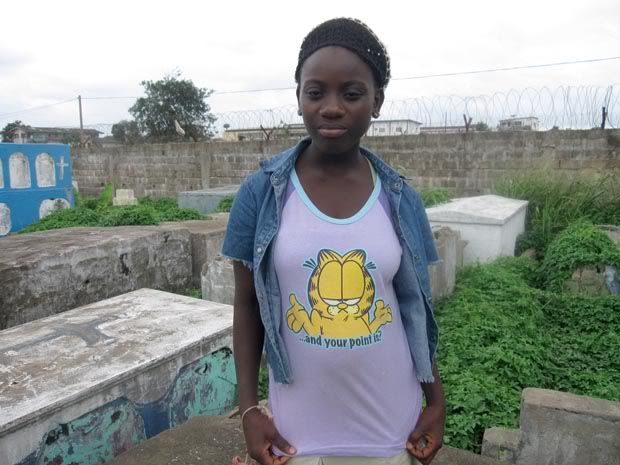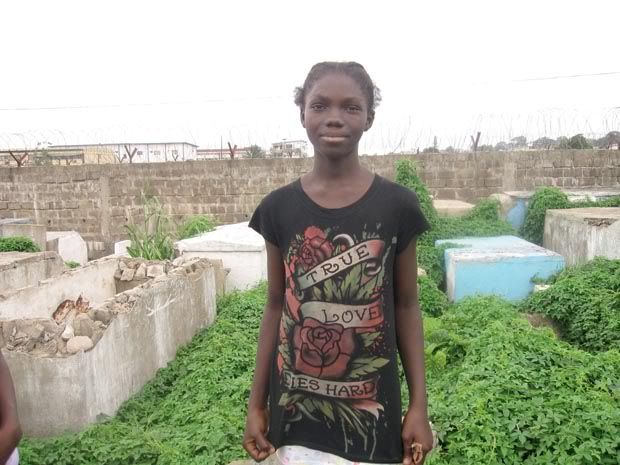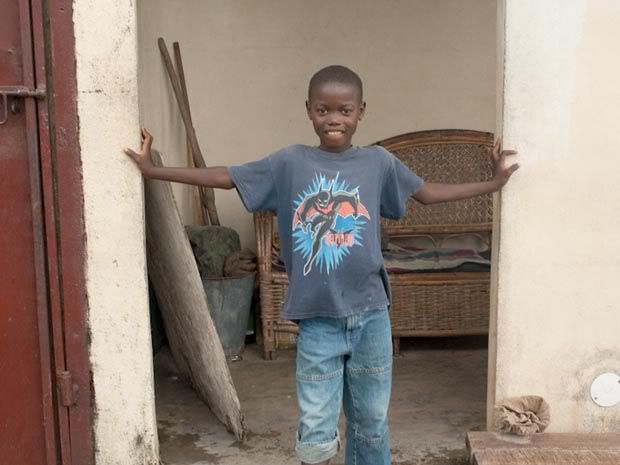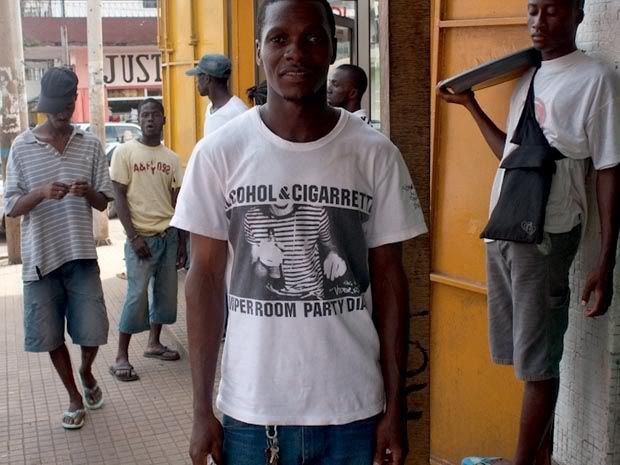This is, in fact, another Vice-based article. And I warn you, it's pretty heavy.
Firstly, if you haven't seen the Guide to Liberia you should watch it in full or by chapter - here it starts at part 1 of 8; you'll need a spare hour-ish to watch it all...
As it goes, Liberia has been through some stuff, yeah? Founded in the 19th century on the backs of freed slaves from America, whose government was modelled on the US's (even their capital city, Monrovia, is named after the 5th president, James Monroe), Liberia has been in turmoil for the past 30 years following a military coup in 1980. This resulted in a civil war and the collapse of the economy which devastated the country, making it one of the poorest, most deprived countries in the world.
Vice filmed all around the slums in Monrovia, which are among the worst slums in the world, and interviewed the inhabitants, including some ex-warlords. They also took a bunch of pictures...




photos from viceland.com
It feels a little disrespectful to then take this into a fashion context, but also, I think, interesting.
These are people, mostly kids, from around the slums of Monrovia. Here, all in vintage style tees. Imagine these on eBay, or in vintage stores, where they would sell for a pretty penny...?
This Vice article offers insight (and makes some good/similar points):
"Supply and demand comes with completely different connotations in Liberia. Demand does not control the goods supplied; it’s the other way around.
Clothing exemplifies this inverted chain. Liberia’s struggling economy does not have enough buying power to dictate what comes into one of the most import-dependent countries in the world. Its war-destroyed infrastructure means there’s very little domestic production of anything.
Some new clothes do make it into the country. But outside the cheap Chinese kitsch sold in the potholed and rubbish-strewn Waterside Market, most new clothing is far outside the affordability of the average Liberian; as many as 60 percent of the country are said to live on a dollar a day.
So, demand creates a different supply chain where low cost is the trump. Donations from the US and the wholesale purchase of massive amounts of used clothes fill hundreds of sea cans with clothing no longer wanted by Americans. These end up all over Africa, but Monrovia—the capital city of a country built by freed slaves of the 19th century in the image of the United States—receives a high proportion of used American garb.
It’s these packed sea cans that set the parameters of style. Trends get set by what shows up in the shipping containers, not the other way around. For example, around Christmas last year, a multi-colour striped t-shirt made of cheap cloth could be found for about 80 cents anywhere in the country. It’s near impossible to pass a day without seeing the “Be the Reds” shirt, produced by the millions to promote South Korea’s football team as they hosted the 2002 World Cup. And sometime in the spring, a wave of cheap top hats showed up on the street, starting a trend for young men on the streets of the capital."
OK, so, from this, I get two trains of thought:
ONE (the heavy one)
Are we in the western world so jaded as to pay so much for what is, essentially, just an old tshirt (or a skirt, or a pair of leggings...)? We consume much too much of everything as it is, but it's becoming a bit of a joke when we're paying £50 for an 80's bodycon dress which are somewhat readily available.
I will excuse the avant garde, and the designer vintage, on the grounds that they are much more rare, much more one off. But a tshirt is a tshirt, and if the vintage piece looks just like something that's all over the highstreet then what's the point?
I always have a reservation with vintage, as much as I love it; so often is it overpriced. I will often turn down pieces on eBay (both vintage and second hand) which I feel are too expensive. It'd have to be a particularly special and/or well made piece for me to consider spending a lot of money on it.
Yeah, and, I'm not entirely with Mary Portas on her charity shop mission (it's connected, what?).
Charities need money, yes, of course, but upping the price of common items is not the way forward imo, for then it is just the same as the overpriced vintage. Better if her mission involved pricing pieces - good quality, rarer, more unique - accordingly, and those which were unlikely to make real money for the charity - high street basics, etc - be sent off to those who do actually need them. Surely places like Liberia would be better served by second hand clothes than those who will buy them from charity shops? Old jeans, leggings, tees?
Of course, having more clothes are the least of their worries, but yknow, every little helps and such.
TWO (the pondering one)
I find it interesting that in such a climate, such ideas as 'fashion trends' are still present. It feels like a very organic route. It is the same as our trend process, but on a basic level.
We see, we want, we buy. Or, more truthfully; we see, the high street decides what's easiest to copy and does so, we buy.
We see, we take, there is no other option is surely the Liberian way, and it seems odd to think of there being a much pared down set of trends, non?
Listing the trends (counting on fingers...) for the new season could take over two hands, but imagine if our trends were determined by purely what was available then and there?
Would it force more creativity (especially in those wishing to stand out)?
Would we feel a sense of community (as we all wore our second hand top hats)?
Would those inclined to design do so still - and if so, would it be a case of re-appropriating available garments, or finding any available fabric with which to create your vision?
I think such a climate could be a creative breeding ground, and would be interested to see what could come out of places such as Liberia given the opportunity. Maybe we should be donating things like unwanted sewing equipment (no electrical products, of course), and then perhaps Liberians and other 'third world' populations could gain a better quality of life.
That sounds a bit 'fashion can save!' but what I mean is...well, if you've seen the videos, you'll know how these people spend their days, and surely anything is better than that.


















7 comments:
This is such an interesting post. I think, though, that it's not entirely true that the trends are driven completely by supply and not demand. The top hats are actually a perfect example. No one *needs* a top hat. It doesn't keep you warm or block the sun from your eyes. It just looks cool. So the trend had to some from one guy and then another and then another seeing a top hat and thinking, "That looks cool. I want to wear that," whether it was in the marketplace or on another guy he saw walking around. Especially when money is tight, no consumer would choose this item over another without a compelling reason. This really shows us how fashion choices (and artistic expression in general) is an essential part of the human experience.
excellent point - i hadn't thought of it that way
jenn.x
In a way this charity shops are loosing sight of their true purpose, sure it’s nice for it to be clean but there is no need for a makeover and selling high street pieces at prices that are higher than those this same stores offer on sales is just too much.
These shops did not come to be just as a play ground for the bargain hunter but as a real help for those who depend on such shops to dress themselves and it’s a shame that we may be loosing sight of that.
And yes the desire to beautify our expression thru clothes is present even in Amazonian tribes that have no actual clothes were women arrange their leaf “skirts” according to trends that can spur from a bird to the most popular priestess, walking incredible distances for the right colored ones.
I do think that instead of Liberia having "trends" the necessity outweighs the aesthetic. What I mean is that, its not "Oh I like these jelly sandals... I want to wear them." Its more, "These shoes are a little big but they cover my feet and keep me from stepping on trash or rocks." I do have a hard time paying a heavy price for vintage when what we are buying is someone's old clothes. You make so many great points.
I do want to point to a country in West Africa and something really beautiful that is occuring. In the country of Ghana, there is a school that brings in about 25 young adult women and teaches them to sew so that they can support themselves and run their own business by making their own clothes and clothes for others. I would be curious to find if something similar exists in Liberia.
great post! I try to cut down on my consuming, its hard when I (we?) were raised to want and need everything. It really puts it into perspective to see people living on $1 a day, why do I really need more 'things' you know. And also when I feel broke, in Canada I've never really experienced it.
some interesting points are raised regarding supply/demand and vintage.
you talk about the price of vintage, and i'll agree, the overpricing can be ridiculous. But the same case can be made for "brand new" articles of clothing. There is literally a higher price for the new: old becomes outre and is disposed of to be replaced by the lastest. New clothes nearly always cost more, in pricetag and in the case of "low priced" new, the price weighs in even heavier. Cheap clothes mean cheap labor, and I'd rather pay too much for vintage and keep clothes out of a landfill than to support sweatshop labor and unsustainable business practices.
Thanks for these comments guys - I really hoped this would spark some debate, as I knew there would be POVs and ideas that I hadn't considered.
Alyson - that would be a great thing, if such a school were in effect (or if it already is) within Liberia.
Eyeliah - It's for certain the culture we in the west have been brought up in. Want and need, want and need.
the Citizen Rosebud - from an ethical standpoint, this is an excellent view. What though, of the 'vintage' shops which stock recent high street second hand and pass it off as vintage, charging more for it? (There's one near me which I refuse to shop in now because it does this.) I think these are bringing down the name of vintage in the name of making money - as such, I can't condemn the low priced new shops, because at least you know what you are getting with them. Most consumers are aware now of the practice of the cheap shops and can make an informed decision as to whether to shop there.
The thing about this post is, I've said things that I'm aware are going to make me a hypocrite, because it's likely I'm not going to cut down on too much on my spending - I won't not buy vintage, or even new, and that's because I have the means/the money to do so. Why wouldn't I?
Seems that we, as humans, have the need, within ourselves, to make trends; to follow, or to lead. Even those who are 'anti-fashion' are still making trends in their own circles; those who don't even have the means are creating their own trends.
Completely unrelated topic, but one which has been floating about the blogs lately. I guess fashion isn't at all frivolous when it's so universal.
jenn.x
Post a Comment